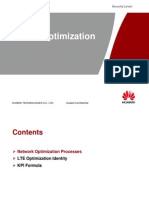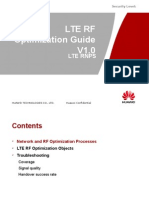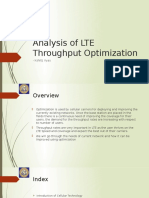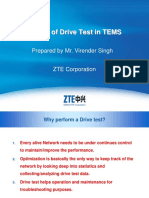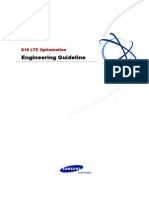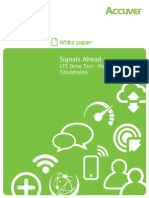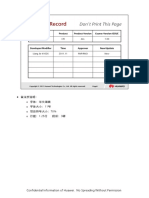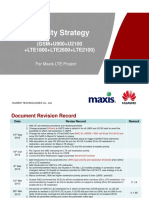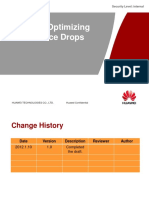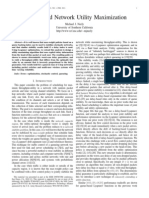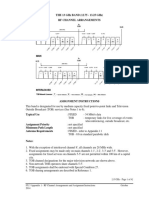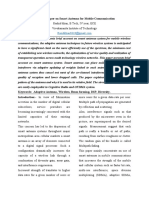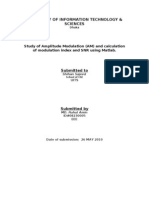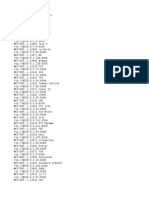LTE RF Optimization Guide
LTE RF Optimization Guide
Uploaded by
Mohamed BGcityCopyright:
Available Formats
LTE RF Optimization Guide
LTE RF Optimization Guide
Uploaded by
Mohamed BGcityCopyright
Available Formats
Share this document
Did you find this document useful?
Is this content inappropriate?
Copyright:
Available Formats
LTE RF Optimization Guide
LTE RF Optimization Guide
Uploaded by
Mohamed BGcityCopyright:
Available Formats
HUAWEI TECHNOLOGIES CO., LTD.
www.huawei.com
Huawei Confidential
Security Level: 2013/9/16
LTE RNPS
LTE RF
Optimization Guide
V1.0
HUAWEI TECHNOLOGIES CO., LTD. Huawei Confidential
Page 2
Change History
Date Version Description Author
0.5 LTE RNPS
1.0 LTE RNPS
HUAWEI TECHNOLOGIES CO., LTD. Huawei Confidential
Page 3
Preface
To meet customers' requirements for high-quality networks, LTE trial
networks must be optimized during and after project implementation. Radio
frequency (RF) optimization is necessary in the entire optimization process.
This document provides guidelines on network optimization for network
planning and optimization personnel.
To meet customers' requirements for high-quality networks, LTE trial
networks must be optimized during and after project implementation. Radio
frequency (RF) optimization is necessary in the entire optimization process.
This document provides guidelines on network optimization for network
planning and optimization personnel.
HUAWEI TECHNOLOGIES CO., LTD. Huawei Confidential
Page 4
Contents
Network and RF Optimization Processes
LTE RF Optimization Objects
Troubleshooting
Coverage
Signal quality
Handover success rate
HUAWEI TECHNOLOGIES CO., LTD. Huawei Confidential
Page 5
Network Optimization Flowchart
New site
on air
Single site
verification
Are clusters
ready?
RF optimization
Service test and
parameter optimization
Are KPI
requirements met?
No
Yes
Yes
No
End
HUAWEI TECHNOLOGIES CO., LTD. Huawei Confidential
Page 6
Network Optimization Process
Single site verification
Single site verification, the first phase of network optimization, involves
function verification at each new site. Single site verification aims to
ensure that each site is properly installed and that parameters are
correctly configured.
RF optimization
RF (or cluster) optimization starts after all sites in a planned area are
installed and verified. RF optimization aims to control pilot pollution
while optimizing signal coverage, increase handover success rates, and
ensure normal distribution of radio signals before parameter
optimization. RF optimization involves optimization and adjustment of
antenna system hardware and neighbor lists. The first RF optimization
test must traverse all cells in an area to rectify hardware faults.
HUAWEI TECHNOLOGIES CO., LTD. Huawei Confidential
Page 7
RF Optimization Flowchart
HUAWEI TECHNOLOGIES CO., LTD. Huawei Confidential
Page 8
Preparations for RF Optimization
Checklist
Network plan, network structure diagram, site distribution, site
information, and engineering parameters
Drive test results (such as service drop points and handover
failure points) in the current area
Reference signal received power (RSRP) coverage diagram
Signal to interference plus noise ratio (SINR) distribution diagram
Measured handover success rates
Areas to be optimized can be determined by comparing the
distribution of RSRPs, SINRs, and handover success rates with
the optimization baseline.
HUAWEI TECHNOLOGIES CO., LTD. Huawei Confidential
Page 9
Network Optimization Methods
RF optimization involves adjustment of azimuths, tilts, antenna height, eNodeB transmit
power, feature algorithms, and performance parameters. Optimization methods in different
standards are similar, but each standard has its own measurement definition.
Network
Optimization
Azimuth Adjustment Tilt Adjustment
Feature Configuration
Reselection and
Handover
Parameter Adjustment
Power Adjustment
Antenna Height
HUAWEI TECHNOLOGIES CO., LTD. Huawei Confidential
Page 10
Contents
Network and RF Optimization Processes
LTE RF Optimization Objects
Troubleshooting
Coverage
Signal quality
Handover success rate
HUAWEI TECHNOLOGIES CO., LTD. Huawei Confidential
Page 11
LTE RF Optimization Objects and
Target Baseline
What are
differences
between LTE
and 3G
optimization?
Text
RSRP
SINR
Handover
success rate
How are
these
counters
defined?
LTE
optimization
objects
HUAWEI TECHNOLOGIES CO., LTD. Huawei Confidential
Page 12
RSRP
Note: Different from GSM or TD-SCDMA systems, TD-LTE systems have multiple subcarriers multiplexed.
Therefore, the measured pilot signal strength is the RSRP of a single subcarrier (15 kHz) not the total
bandwidth power of the frequency.
The RSRPs near a cell, in the middle of a cell, and at the edge of a cell are determined based on the
distribution of signals on the entire network. Generally, the RSRP near a cell is -85 dBm, the RSRP in the
middle of a cell is -95 dBm, and the RSRP at the edge of a cell is -105 dBm.
Currently, the minimum RSRP for UEs to camp on a cell is -120 dBm.
Empirical RSRP at the edge of a cell:
The RSRP is greater than -110 dBm in 99% areas at the TD-LTE site in Norway.
The RSRP is greater than -110 dBm in 98.09% areas in the Huayang field in Chengdu.
Reference signal received power (RSRP), is determined for a
considered cell as the linear average over the power
contributions (in [W]) of the resource elements that carry cell-
specific reference signals within the considered measurement
frequency bandwidth.
3GPP
definition
HUAWEI TECHNOLOGIES CO., LTD. Huawei Confidential
Page 13
SINR
The SINR is not specifically defined in 3GPP specifications. A common formula is as
follows:
SINR = S/(I + N)
S: indicates the power of measured usable signals. Reference signals (RS) and physical
downlink shared channels (PDSCHs) are mainly involved.
I: indicates the power of measured signals or channel interference signals from other
cells in the current system and from inter-RAT cells.
N: indicates background noise, which is related to measurement bandwidths and receiver
noise coefficients.
Empirical SINR at the edge of a cell:
The SINR is greater than -3 dB in 99% areas in Norway.
The SINR is greater than -3 dB in 99.25% areas in the Huayang field in Chengdu.
HUAWEI TECHNOLOGIES CO., LTD. Huawei Confidential
Page 14
Handover Success Rate
According to the signaling process in 3GPP TS 36.331,
eNodeB statistics
(1) Handover success rate = Number of handovers/Number of handover
attempts x 100%
(2) Number of handover attempts: indicates the number of eNodeB-
transmitted RRCConnectionReconfiguration messages for handovers.
(3) Number of handovers: indicates the number of eNodeB-received
RRCConnectionReconfigurationComplete messages for handovers.
Handover success rate
The handover success rate is greater than 97% at the TD-LTE site in
Norway.
The handover success rate is 100% in the Huayang field in Chengdu.
HUAWEI TECHNOLOGIES CO., LTD. Huawei Confidential
Page 15
Power Adjustment Method
Service power configuration (calculating PDSCH power based
on RS power)
RS power PA and PB are delivered using RRC signaling. For
two antennas, PA is A and B is calculated based on the right
table. PDSCH power is calculated based on PA and PB.
Currently, it is recommended that PB be set to 1 dB and PA be
set to -3 dB. That is, the pilot power for symbols including pilot
symbols accounts for 1/3. This setting optimizes network
performance and ensures that the pilot power for Type A and
Type B symbols is equivalent to the service channel power. In
scenarios with special requirements, for example, in rural
scenarios requiring low edge rates, PB can be set to 2 or 3 dB to
enhance coverage.
Subcarriers share the transmit power of an eNodeB, and therefore the transmit power
of each subcarrier depends on the configured system bandwidth (such as 5 MHz and 10
MHz). A larger bandwidth will result in lower power of each subcarrier. LTE uses PA and
PB parameters to adjust power.
A: indicates the ratio of the data subcarrier power of OFDM symbols excluding pilot
symbols to the pilot subcarrier power.
B: indicates the ratio of the data subcarrier power of OFDM symbols including pilot
symbols to the pilot subcarrier power.
Definitions in
3GPP
specifications
Control channels
Power of PDCCHs, PHICHs, PCFICHs,
PBCHs, primary synchronization channels,
and secondary synchronization channels is
set using an offset from RS power.
HUAWEI TECHNOLOGIES CO., LTD. Huawei Confidential
Page 16
Contents
Network and RF Optimization Processes
LTE RF Optimization Objects
Troubleshooting
Coverage
Signal quality
Handover success rate
HUAWEI TECHNOLOGIES CO., LTD. Huawei Confidential
Page 17
Classification of Coverage Problems
(RSRP is mainly involved)
Weak coverage and
coverage holes
Cross coverage
Imbalance between
uplink and downlink
Lack of a
dominant cell
Continuous
coverage must be
ensured.
The actual
coverage must be
consistent with the
planned one to
prevent service
drops caused by
isolated islands
during handovers.
Uplink and
downlink losses
must be balanced
to resolve uplink
and downlink
coverage
problems.
Each cell on a
network must
have a dominant
coverage area to
prevent frequent
reselections or
handovers
caused by signal
changes.
HUAWEI TECHNOLOGIES CO., LTD. Huawei Confidential
Page 18
Factors Affecting Coverage
1
Downlink:
Equivalent isotropic
radiated power (EIRP)
Total transmit power
Combining loss
Path loss (PL)
Frequency band
Distance between a receive
point and an eNodeB
Scenarios (urban and
suburban areas) and terrains
(plains, mountains, and hills)
of electric wave propagation
Antenna gain
Antenna height
Antenna parameters
(antenna pattern)
Antenna tilt
Antenna azimuth
2
Uplink:
eNodeB receiver sensitivity
Antenna diversity gain
UE transmit power
Propagation loss of uplink
radio signals
Impact of tower-mounted
amplifiers (TMAs) on uplink
HUAWEI TECHNOLOGIES CO., LTD. Huawei Confidential
Page 19
Weak Coverage and Coverage Holes
The signal quality in cells is poorer than the optimization baseline in an area.
As a result, UEs cannot be registered with the network or accessed services
cannot meet QoS requirements.
If there is no network coverage or coverage levels are excessively low in an area, the
area is called a weak coverage area. The receive level of a UE is less than its
minimum access level (RXLEV_ACCESS_MIN) because downlink receive levels in a
weak coverage area are unstable. In this situation, the UE is disconnected from the
network. After entering a weak coverage area, UEs in connected mode cannot be
handed over to a high-level cell, and even service drops occur because of low levels
and signal quality.
Weak
coverage
Coverage holes
HUAWEI TECHNOLOGIES CO., LTD. Huawei Confidential
Page 20
Resolving Weak Coverage Problems
Analyze geographical
environments and check the
receive levels of adjacent
eNodeBs.
Analyze the EIRP of each
sector based on parameter
configurations and ensure
EIRPs can reach maximum
values if possible.
Increase pilot power.
Adjust antenna azimuths and
tilts, increase antenna height,
and use high-gain antennas.
Deploy new eNodeBs if
coverage hole problems
cannot be resolved by
adjusting antennas.
Increase coverage by
adjacent eNodeBs to achieve
large coverage overlapping
between two eNodeBs and
ensure a moderate handover
area.
Note: Increasing coverage
may lead to co-channel and
adjacent-channel
interference.
Use RRUs, indoor
distribution systems, leaky
feeders, and directional
antennas to resolve the
problem with blind spots in
elevator shafts, tunnels,
underground garages or
basements, and high
buildings.
Analyze the impact of
scenarios and terrains on
coverage.
HUAWEI TECHNOLOGIES CO., LTD. Huawei Confidential
Page 21
Case: Searching for a Weak Coverage Area by
Using a Scanner or Performing Drive Tests on
UEs
Weak
coverage
area
Perform drive tests in zero-
load environments to obtain
the distribution of signals on
test routes. Then, find a
weak coverage area based
on the distribution, as
shown in the figure.
Adjust RF parameters of the
eNodeB covering the area.
HUAWEI TECHNOLOGIES CO., LTD. Huawei Confidential
Page 22
Lack of a Dominant Cell
In an area without a dominant cell, the receive level of the serving cell is similar to the
receive levels of its neighboring cells and the receive levels of downlink signals between
different cells are close to cell reselection thresholds. Receive levels in an area without a
dominant cell are also unsatisfactory. The SINR of the serving cell becomes unstable
because of frequency reuse, and even receive quality becomes unsatisfactory. In this
situation, a dominant cell is frequently reselected and changed in idle mode. As a result,
frequent handovers or service drops occur on UEs in connected mode because of poor
signal quality. An area without a dominant cell can also be regarded as a weak coverage
area.
Lack of a
dominant
cell
HUAWEI TECHNOLOGIES CO., LTD. Huawei Confidential
Page 23
Resolving Problems with Lack of a
Dominant Cell
Adjust engineering
parameters of a cell that can
optimally cover the area as
required.
Determine cells covering an
area without a dominant cell
during network planning, and
adjust antenna tilts and
azimuths to increase coverage
by a cell with strong signals
and decrease coverage of
other cells with weak signals.
HUAWEI TECHNOLOGIES CO., LTD. Huawei Confidential
Page 24
Symptom
UEs frequently perform cell reselections
or handovers between identical cells.
Analysis
Analysis can be based on signaling
procedures and PCI distribution.
According to PCI distribution shown in
the figure, PCIs alternate in two or more
colors if there is no dominant cell.
Solution
According to the coverage plan, cell 337
is a dominant cell covering the area and cell
49 also has strong signals. To ensure
handovers between cells 337 and 49 at
crossroads, increase tilts in cell 49.
1.PCI distribution in cluster xx
Lack of a
dominant
cell
Case: Searching for an Area
Without a Dominant Cell
HUAWEI TECHNOLOGIES CO., LTD. Huawei Confidential
Page 25
Cross Coverage
Cross coverage means that the coverage scope of an eNodeB exceeds the planned one and
generates discontinuous dominant areas in the coverage scope of other eNodeBs. For
example, if the height of a site is much higher than the average height of surrounding
buildings, its transmit signals propagate far along hills or roads and form dominant
coverage in the coverage scope of other eNodeBs. This is an island phenomenon. If a call
is connected to an island that is far away from an eNodeB but is still served by the eNodeB,
and cells around the island are not configured as neighboring cells of the current cell when
cell handover parameters are configured, call drops may occur immediately once UEs leave
the island. If neighboring cells are configured but the island is excessively small, call drops
may also occur because UEs are not promptly handed over. In addition, cross coverage
occurs on two sides of a bay because a short distance between the two sides. Therefore,
eNodeBs on two sides of a bay must be specifically designed.
Cross
coverage
HUAWEI TECHNOLOGIES CO., LTD. Huawei Confidential
Page 26
Resolving Cross Coverage Problems
Adjust antenna tilts or
replace antennas with large-tilt
antennas while ensuring
proper antenna azimuths. Tilt
adjustment is the most
effective approach to control
coverage. Tilts are classified
into electrical tilts and
mechanical tilts. Electrical tilts
are preferentially adjusted if
possible.
Adjust antenna azimuths
properly so that the direction
of the main lobe slightly
obliques from the direction of
a street. This reduces
excessively far coverage by
electric waves because of
reflection from buildings on
two sides of the street.
Decrease the antenna
height for a high site.
Decrease transmit power of
carriers when cell
performance is not affected.
HUAWEI TECHNOLOGIES CO., LTD. Huawei Confidential
Page 27
Case: Cross Coverage Caused
by Improper Tilt Settings
Symptom
As shown in the upper right figure, cross
coverage occurs in a cell whose PCI is
288. Therefore, the cell interferes with
other cells, which increases the
probability of service drops.
Analysis
The most possible cause for cross
coverage is excessively antenna height
or improper tilt settings. According to a
check on the current engineering
parameter settings, the tilt is set to an
excessively small value. Therefore, it is
recommended that the tilt be increased.
Solution
Adjust the tilt of cell 288 from 3 to 6. As
shown in the lower right figure, cross
coverage of cell 288 is significantly
reduced after the tilt is adjusted.
HUAWEI TECHNOLOGIES CO., LTD. Huawei Confidential
Page 28
Case: Inverse Connections Involved
in the Antenna System
Symptom
The RSRPs of cells 0 and 2 at the Expo Village site are low and high respectively in
the red area shown in the figure. The signal quality of cells 0 and 2 is satisfactory in
the areas covered by cells 2 and 0 respectively.
Analysis
After installation and commissioning are complete, the RSRP in the direction of the
main lobe in cell 0 is low. After cell 0 is disabled and cell 2 is enabled, the RSRP in cell
2 is normal and the SINR is higher than that tested in cell 0. Therefore, this problem
may occur because the antenna systems in the two cells are connected inversely.
Test results are as expected after optical fibers on the baseband board are swapped.
Solution
Swap optical fibers on the baseband board or adjust feeders and antennas properly. It
is recommended that optical fibers on the baseband board be swapped because this
operation can be performed in the equipment room.
Suggestions
Network planning personnel must participate in installation. Alternatively, customer
service personnel have detailed network planning materials and strictly supervise
project constructors for installation. After installation is complete, labels must be
attached and installation materials must be filed.
HUAWEI TECHNOLOGIES CO., LTD. Huawei Confidential
Page 29
Imbalance Between Uplink and
Downlink
When UE transmit power is less than eNodeB transmit power, UEs in idle mode may receive
eNodeB signals and successfully register in cells. However, the eNodeB cannot receive
uplink signals because of limited power when UEs perform random access or upload data.
In this situation, the uplink coverage distance is less than the downlink coverage distance.
Imbalance between uplink and downlink involves limited uplink or downlink coverage. In
limited uplink coverage, UE transmit power reaches its maximum but still cannot meet the
requirement for uplink BLERs. In limited downlink coverage, the downlink DCH transmit
code power reaches its maximum but still cannot meet the requirement for the downlink
BLER. Imbalance between uplink and downlink leads to service drops. The most common
cause is limited uplink coverage.
Imbalance
between
uplink and
downlink
Uplink coverage area
Downlink coverage area
coverage area
HUAWEI TECHNOLOGIES CO., LTD. Huawei Confidential
Page 30
Resolving Problems with Imbalance
Between Uplink and Downlink
If no performance data is available for
RF optimization, trace a single user in the
OMC equipment room to obtain uplink
measurement reports on the Uu interface,
and then analyze the measurement
reports and drive test files.
If performance data is available, check
each carrier in each cell for imbalance
between uplink and downlink based on
uplink and downlink balance
measurements.
If uplink interference leads to imbalance
between uplink and downlink, monitor
eNodeB alarms to check for interference.
Check whether equipment works properly
and whether alarms are generated if
imbalance between uplink and downlink is
caused by other factors, for example, uplink
and downlink gains of repeaters and trunk
amplifiers are set incorrectly, the antenna
system for receive diversity is faulty when
reception and transmission are separated,
or power amplifiers are faulty. If equipment
works properly or alarms are generated,
take measures such as replacement,
isolation, and adjustment.
HUAWEI TECHNOLOGIES CO., LTD. Huawei Confidential
Page 31
Contents
Network and RF Optimization Processes
LTE RF Optimization Objects
Troubleshooting
Coverage
Signal quality
Handover success rate
HUAWEI TECHNOLOGIES CO., LTD. Huawei Confidential
Page 32
Signal Quality (SINR is mainly
involved)
Frequency
plan
Site
selection
Antenna
height
Antenna
azimuths
Antenna tilts
Cell layout
HUAWEI TECHNOLOGIES CO., LTD. Huawei Confidential
Page 33
Resolving Signal Quality Problems
Caused by Improper Parameter Settings
Change and optimize frequencies based on drive test and
performance measurement data.
Optimizing
frequencies
Adjust antenna azimuths and tilts to change the distribution of signals in an
interfered area by increasing the level of a dominant sector and decreasing levels of
other sectors.
Adjusting the
antenna
system
Increase power of a cell and decrease power of other cells to form a dominant
cell.
Decrease RS power to reduce coverage if the antenna pattern is distorted because
of a large antenna tilt.
Power adjustment and antenna system adjustment can be used together.
Adding
dominant
coverage
Adjusting
power
HUAWEI TECHNOLOGIES CO., LTD. Huawei Confidential
Page 34
Case: Adjusting Antenna Azimuths and Tilts
to Reduce Interference
Symptom
Cross coverage occurs at sites 1, 2, 3, 7, 8, 9, 10, 11, and 12, and co-channel interference occurs
in many areas.
Analysis
According to the analysis of engineering parameters and drive test data, cell density is large in
coverage areas. Coverage by each cell can be reduced by adjusting antenna azimuths and tilts.
Solution
Change the tilt in cell 28 from 2 degrees to 4 degrees so that the direction points to a
demonstration route. Change the tilt in cell 33 from 3 degrees to 6 degrees so that the direction
points to the Wanke Pavilion. Change the tilt in cells 50 and 51 from 3 degrees to 6 degrees so
that the direction points to the Communication Pavilion. Decrease the transmit power in cell 33 by
3 dB to reduce its interference to overhead footpaths near China Pavilion.
SINR before optimization in Puxi SINR after optimization in Puxi
Poor signal
quality before
optimization
HUAWEI TECHNOLOGIES CO., LTD. Huawei Confidential
Page 35
Case: Changing PCIs of Intra-frequency Cells
to Reduce Interference
Symptom
Near J apan Pavilion, UEs access a cell whose PCI is 3 and SINRs are low. UEs are about 200 m away from the
eNodeB. This problem may be caused by co-channel interference.
Analysis
This problem is not caused by co-channel interference because no neighboring cell has the same frequency as the
current cell. Cell 6 interferes with cell 3. SINRs increase after cell 6 is disabled. In theory, staggered PCIs can
reduce interference.
Solution
Change PCI 6 to PCI 8. Test results show that SINRs increase by about 10 dB.
SINR when cell 6 is enabled SINR when cell 6 is disabled SINR when PCI 6 is changed to PCI 8
HUAWEI TECHNOLOGIES CO., LTD. Huawei Confidential
Page 36
Case: Handover Failure Caused by
Severe Interference
Symptom
During a test, handovers from PCI 281 to PCI 279 fail.
Analysis
Cell 281 is a source cell and is interfered by cells 279 and 178. Delivered handover
commands always fail and cannot be received correctly by UEs. Cell 279 is a target cell
for handover, and its coverage is not adjusted preferentially because the signal strength
in the handover area can ensure signal quality after handovers. Therefore, cell 178 must
be adjusted to reduce its interference to cell 281.
Solution
Adjust antenna tilts to decrease coverage by cell 178.
HUAWEI TECHNOLOGIES CO., LTD. Huawei Confidential
Page 37
Contents
Network and RF Optimization Processes
LTE RF Optimization Objects
Troubleshooting
Coverage
Signal quality
Handover success rate
HUAWEI TECHNOLOGIES CO., LTD. Huawei Confidential
Page 38
Analysis of Handover Success Rate
Problems
Neighboring cell optimization must be performed to ensure that UEs in idle or
connected mode can promptly perform reselection to or be handed over to
optimal serving cells. This helps achieve continuous coverage. In addition,
problems with delay, ping-pong, and non-logical handovers can be resolved by
optimizing coverage, interference, and handover parameters.
HUAWEI TECHNOLOGIES CO., LTD. Huawei Confidential
Page 39
Handover Problem Analysis
Checking handover validity
Obtain source and target cells using drive test software and then check whether handovers are
performed between two cells that are geographically far using Mapinfo.
Checking interference
Check interference in both source and target cells because handover failures may be caused
by uplink or downlink interference.
Checking coverage
Check source and target cells for cross coverage, imbalance between uplink and downlink, and
carrier-level receive quality and level.
Check contents
Check handovers based on RSRPs measured in UE drive tests.
1. Verify that RSRPs in the expected source and target cells are maximum.
2. Verify that the absolute RSRPs in the source and target cells are reasonable at a
handover point. In other words, handovers are not allowed if signal quality is excessively
poor. Specific RSRPs are determined based on the entire RSRPs on a network.
HUAWEI TECHNOLOGIES CO., LTD. Huawei Confidential
Page 40
Case: Service Drops Caused by Missing
Neighboring Cell Configuration
Symptom
As shown in the upper right figure, a
UE sends multiple measurement
reports but is not handed over,
which may be caused by missing
neighboring cell configuration.
Analysis
According to measurement reports,
the UE sends an A3 report of cell
64. However, the
RRCConnectionReconfiguration
message in the lower right figure
shows that the current cell is cell
278 (the first cell) and cell 64 is not
included in the message. This
indicates that cells 278 and 64 are
not configured as neighboring cells.
Neighboring cell configuration on
live networks can be checked for
further confirmation.
Solution
Configure cells 278 and 64 as
neighboring cells.
HUAWEI TECHNOLOGIES CO., LTD. Huawei Confidential
Page 41
Summary
RF optimization involves adjustment of neighboring cell lists and engineering parameters.
Most coverage and interference problems can be resolved by taking the following measures
(sorted in descending order by priority):
Adjusting antenna tilts
Adjusting antenna azimuths
Adjusting antenna height
Adjusting antenna position
Adjusting antenna types
Adding TMAs
Adjusting site position
Adding sites or RRUs
This document describes what are involved in the RF optimization phase of network optimization. RF optimization
focuses on improvement of signal distribution and provides a good radio signal environment for subsequent
service parameter optimization. RF optimization mainly use drive tests, which can be supplemented by other tests.
RF optimization focuses on coverage and handover problems, which can be supplemented by other problems. RF
optimization aims to resolve handover, service drop, access, and interference problems caused by these
problems. Engineering parameters and neighboring cell lists are adjusted in the RF optimization phase, while cell
parameters are adjusted in the parameter optimization phase.
Thank you
www.huawei.com
You might also like
- JAN 2024 Cable News Program Ranker (Total Viewers & Adults 25-54)Document8 pagesJAN 2024 Cable News Program Ranker (Total Viewers & Adults 25-54)AdweekNo ratings yet
- Mobile Network Optimization: A Guide for 2G and 3G Mobile Network OptimizationFrom EverandMobile Network Optimization: A Guide for 2G and 3G Mobile Network OptimizationRating: 3.5 out of 5 stars3.5/5 (3)
- LTE TroubleshootingDocument44 pagesLTE Troubleshootingsumit100% (5)
- LTE OptimizationDocument18 pagesLTE OptimizationAkhtar Khan92% (13)
- Indoor Radio Planning: A Practical Guide for 2G, 3G and 4GFrom EverandIndoor Radio Planning: A Practical Guide for 2G, 3G and 4GRating: 5 out of 5 stars5/5 (1)
- LTE Service KPIDocument102 pagesLTE Service KPIManuel_VINo ratings yet
- LTE Network OptimizationDocument89 pagesLTE Network Optimizationmr_greenberet100% (6)
- LTE Optimization GuidelineDocument55 pagesLTE Optimization GuidelineBernard Jason100% (5)
- LTE PCI Planning GuideDocument34 pagesLTE PCI Planning GuideUzair Tanveer100% (6)
- LTE KPI OptimizationDocument17 pagesLTE KPI OptimizationMuhammd Sohail Khan0% (3)
- LTE NPO LTE PrincipleDocument90 pagesLTE NPO LTE PrinciplePhuc Tran100% (1)
- Measurement 5G Drive TestDocument54 pagesMeasurement 5G Drive TestMohd Azizul Khairuddin100% (1)
- Ssvs Training: Huawei Technologies Co., LTDDocument14 pagesSsvs Training: Huawei Technologies Co., LTDEdwin Llugsha100% (2)
- LTE Signaling: Troubleshooting and OptimizationFrom EverandLTE Signaling: Troubleshooting and OptimizationRating: 3.5 out of 5 stars3.5/5 (2)
- LTE OptimizationDocument38 pagesLTE Optimizationmanuel50% (2)
- Fundamentals of Network Planning and Optimisation 2G/3G/4G: Evolution to 5GFrom EverandFundamentals of Network Planning and Optimisation 2G/3G/4G: Evolution to 5GNo ratings yet
- LTE CELL Planning: Security LevelDocument31 pagesLTE CELL Planning: Security Levelwiwitraharjo100% (1)
- Analysis of LTE Throughput Using OptimizationDocument34 pagesAnalysis of LTE Throughput Using Optimizationronak14267% (3)
- 05 WCDMA RF OptimizationDocument127 pages05 WCDMA RF OptimizationIyesusgetanewNo ratings yet
- LTE Drive Test ParametersDocument8 pagesLTE Drive Test ParametersRohan Das100% (1)
- Basics of Drive Test in TEMS: Prepared by Mr. Virender SinghDocument45 pagesBasics of Drive Test in TEMS: Prepared by Mr. Virender SinghSatyenderKumarNo ratings yet
- LTE Optimization GuidelineDocument55 pagesLTE Optimization Guidelineaxenic0450% (2)
- Trial 5G DT & Performance R Eport (Before) : Huawei Technologies Co., LTDDocument20 pagesTrial 5G DT & Performance R Eport (Before) : Huawei Technologies Co., LTDIschak ChaerudinNo ratings yet
- UL Interference Analysis ProcedureDocument10 pagesUL Interference Analysis ProcedureKuda BetinaNo ratings yet
- Lte Kpi DT Guide & Measure Method.Document34 pagesLte Kpi DT Guide & Measure Method.Archibong Ibanga100% (4)
- LTE Drive Test PDFDocument31 pagesLTE Drive Test PDFRidho Ah100% (1)
- Technical Guide To LTE Throughput DT Data-Based Accurate Network OptimizationDocument62 pagesTechnical Guide To LTE Throughput DT Data-Based Accurate Network OptimizationBassem Abouamer100% (1)
- PRACH PlanningDocument15 pagesPRACH Planninganwar aziz100% (8)
- Huawei - LTE Network Tuning Issue - 1Document28 pagesHuawei - LTE Network Tuning Issue - 1NikNo ratings yet
- LTE Resource Usage OptimizationDocument54 pagesLTE Resource Usage OptimizationSunil Kumar100% (6)
- LTE Capacity Monitoring - V2Document2 pagesLTE Capacity Monitoring - V2Mohammed El Hammaoui100% (1)
- Carrier Aggregation in LTE-AdvancedDocument32 pagesCarrier Aggregation in LTE-AdvancedRockson Kwame Agyeman67% (3)
- LTE Drive Test & Network Analysis PDFDocument132 pagesLTE Drive Test & Network Analysis PDFRay Khastur100% (2)
- Symena LTE Network Design Using Capesso LTE ADocument18 pagesSymena LTE Network Design Using Capesso LTE ALTE_simulatorNo ratings yet
- Cluster Report LTE TSEL CIAMIS 02Document27 pagesCluster Report LTE TSEL CIAMIS 02IyesusgetanewNo ratings yet
- LTE DRX and Signaling Control ISSUE 1.00Document65 pagesLTE DRX and Signaling Control ISSUE 1.00trio7884No ratings yet
- CQI Adjustment Based On BLER TargetDocument14 pagesCQI Adjustment Based On BLER TargetBettahar Mohamed100% (1)
- LTE Breakdown CounterDocument63 pagesLTE Breakdown CounterAnonymous 1KI43V4d0% (1)
- Guide To Optimizing LTE Service DropsDocument52 pagesGuide To Optimizing LTE Service Dropsfidelkaey100% (2)
- LTE OptimizationDocument17 pagesLTE OptimizationVarsan100% (1)
- Huawei Inter RAT HO OptimizationDocument23 pagesHuawei Inter RAT HO OptimizationNandhu NadhuNo ratings yet
- Call Drop Analysis GuidelineDocument19 pagesCall Drop Analysis GuidelineFerry Alfredo HutajuluNo ratings yet
- Lte High Capacity Event ParametersDocument30 pagesLte High Capacity Event ParametersSandeep Kumar Mahey92% (12)
- LTE Radio Capacity ThroughputDocument45 pagesLTE Radio Capacity Throughputamitvit3100% (1)
- Features/Prameters LTE OptimizationDocument3 pagesFeatures/Prameters LTE OptimizationFuzail Khan67% (3)
- (Huawei) WCDMA Radio Parameters Optimization CasesDocument88 pages(Huawei) WCDMA Radio Parameters Optimization CasesAbDalla Yabarow100% (13)
- HuaweiDocument66 pagesHuaweiDaniel YulistianNo ratings yet
- Lte KpiDocument19 pagesLte KpiMohammad Kamruzzaman100% (6)
- SPD LTE RF Channel Troubleshooting Guide 20120718 A 1 0Document44 pagesSPD LTE RF Channel Troubleshooting Guide 20120718 A 1 0Ahmed GamalNo ratings yet
- VoLTE and ViLTE: Voice and Conversational Video Services over the 4G Mobile NetworkFrom EverandVoLTE and ViLTE: Voice and Conversational Video Services over the 4G Mobile NetworkNo ratings yet
- LTE Self-Organising Networks (SON): Network Management Automation for Operational EfficiencyFrom EverandLTE Self-Organising Networks (SON): Network Management Automation for Operational EfficiencySeppo HämäläinenNo ratings yet
- Fundamentals of Cellular Network Planning and Optimisation: 2G/2.5G/3G... Evolution to 4GFrom EverandFundamentals of Cellular Network Planning and Optimisation: 2G/2.5G/3G... Evolution to 4GNo ratings yet
- Radio Network Planning and Optimisation for UMTSFrom EverandRadio Network Planning and Optimisation for UMTSJaana LaihoRating: 4.5 out of 5 stars4.5/5 (2)
- We Develop Ourselves and OthersDocument10 pagesWe Develop Ourselves and OthersMohamed BGcityNo ratings yet
- Deep Dielectric ChargingDocument31 pagesDeep Dielectric ChargingMohamed BGcityNo ratings yet
- Delay Based Ton S7Document14 pagesDelay Based Ton S7Mohamed BGcityNo ratings yet
- V Foreword VI Preface VII Authors' Profiles VIII Convention Ix Abbreviations X List of Tables Xi List of Figures Xii 1 1Document152 pagesV Foreword VI Preface VII Authors' Profiles VIII Convention Ix Abbreviations X List of Tables Xi List of Figures Xii 1 1July Rodriguez100% (3)
- Ni Introduction Wireless Sensor NetworksDocument36 pagesNi Introduction Wireless Sensor NetworkskalpanasripathiNo ratings yet
- Nim On GraphDocument46 pagesNim On GraphManas MaheshwariNo ratings yet
- Channel Estimation Using SDR4All: A Case Study: Leonardo S. Cardoso M Erouane DebbahDocument21 pagesChannel Estimation Using SDR4All: A Case Study: Leonardo S. Cardoso M Erouane DebbahMohamed BGcityNo ratings yet
- Relationship Between Time Reversal and Linear Equalization in DCDocument3 pagesRelationship Between Time Reversal and Linear Equalization in DCMohamed BGcityNo ratings yet
- MIMO Channel Modeling and The Principle of Maximum EntropyDocument24 pagesMIMO Channel Modeling and The Principle of Maximum EntropyMohamed BGcityNo ratings yet
- Cloud ComputingDocument23 pagesCloud ComputingMohamed BGcityNo ratings yet
- Car FM Antenna 52Document4 pagesCar FM Antenna 52CNEMWNo ratings yet
- Modulation-Part 2-FMDocument67 pagesModulation-Part 2-FMAzmilWahabNo ratings yet
- TVDocument2 pagesTVrizkiNo ratings yet
- 01 Nederlandse Programma StichtingDocument4 pages01 Nederlandse Programma StichtingMilena ŠmigićNo ratings yet
- MCQs Communication TheoryDocument16 pagesMCQs Communication TheoryAli ShamkiNo ratings yet
- Plan de Fréquence 13gDocument4 pagesPlan de Fréquence 13gnoircyNo ratings yet
- 07-Compact High Gain and Wide Azimuth Beam Filtenna For V2X CommunicationDocument6 pages07-Compact High Gain and Wide Azimuth Beam Filtenna For V2X Communicationreza.roooodi1377No ratings yet
- Avia - HCMCDocument15 pagesAvia - HCMCmr.ntien92No ratings yet
- 19 Element YagiDocument4 pages19 Element YagiVanessa BileNo ratings yet
- Full List of Xumo PlayDocument3 pagesFull List of Xumo Playfcmarketing58No ratings yet
- Television Servicing UK 1982 06Document60 pagesTelevision Servicing UK 1982 06insuablancoNo ratings yet
- EdipturkmenogluDocument6,267 pagesEdipturkmenogluelcin mamedovNo ratings yet
- A Review Paper On Smart Antenna For Mobile CommunicationDocument5 pagesA Review Paper On Smart Antenna For Mobile CommunicationEr Rasid KhanNo ratings yet
- Study of Amplitude Modulation (AM) and Calculation of Modulation Index and SNR Using Matlab.Document5 pagesStudy of Amplitude Modulation (AM) and Calculation of Modulation Index and SNR Using Matlab.Md. Ruhul AminNo ratings yet
- Es 100420 Dailyiptvm3u Com-1Document2 pagesEs 100420 Dailyiptvm3u Com-1andrew dantNo ratings yet
- WWK-861 User ManualDocument8 pagesWWK-861 User ManualIvan NekićNo ratings yet
- Antenne Eggbeater Engl Part1 FullDocument10 pagesAntenne Eggbeater Engl Part1 Full11090482No ratings yet
- TYDB 172720DEI4 33FT2v04Document1 pageTYDB 172720DEI4 33FT2v04kuzdubaev rustamNo ratings yet
- RFI Antenna Catalogue PDFDocument207 pagesRFI Antenna Catalogue PDFChristianGuevaraNo ratings yet
- Angle-ModulationQ - Simple TestDocument1 pageAngle-ModulationQ - Simple TestPrincess Haifah SalazarNo ratings yet
- Ecc4100 SkyphyII Dvb-s2 Transceiver Datasheet 007 LoResDocument4 pagesEcc4100 SkyphyII Dvb-s2 Transceiver Datasheet 007 LoResJackson Dias RochaNo ratings yet
- Broadcast MediaDocument19 pagesBroadcast MediaMa.Zusette RodriguezNo ratings yet
- Mov VLCDocument12 pagesMov VLCknncdsijcdsNo ratings yet
- Paper Ets - Muhammad Satria - 0420040030Document18 pagesPaper Ets - Muhammad Satria - 0420040030Satria PurbiNo ratings yet
- Assignment 1 PDFDocument1 pageAssignment 1 PDFThedre ThuivanNo ratings yet
- Yaesu VX-2R Service ManualDocument44 pagesYaesu VX-2R Service Manualasot99100% (2)
- Company TemplateDocument23 pagesCompany Templatebharat_19No ratings yet
- Wong Ngee HuiDocument5 pagesWong Ngee HuiNGUYENCUONG2325No ratings yet
- Mlo4C: Assembly InstructionsDocument8 pagesMlo4C: Assembly Instructionsbellscb100% (2)



